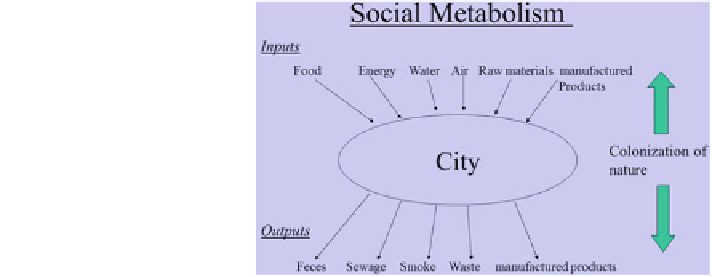Geoscience Reference
In-Depth Information
Fig. 6.1 Social metabolism
of a city. Adapted from Schott
(
2011
)
framework for a differentiated understanding of all kinds of environmental inter-
ventions (Fig.
6.1
).
'
Metabolism
'
of a society is de
ned as,
'
the sum of all input and output between
the biosphere/geosphere and society.
as the
sum of all purposive changes made in natural systems that aim to render nature
more useful for society
'
Colonizing interventions are de
ned
'
.
3
The concept looks at resources which are essential for the reproduction of a city
on both the level of physical reproduction of the urban residents (including ani-
mals), i.e. their
'
metabolism as well as collective reproduction of the city
as a social, economic and cultural system, i.e. the construction and maintenance of
houses, collective buildings such as churches, streets, walls etc., the material pro-
duction of goods for the needs of the urban residents themselves or for trade to
import necessary resources from other places. On the input side, food stuff, raw
materials, water, energy and air
'
biological
'
ow into the city to be consumed, processed and
transformed there. On the output side through biological metabolism and through
material production all kinds of products are set free which
—
since their purpose
was to generate revenue outside the city, as they were no longer immediately useful
or even potentially dangerous for the city and its residents
—
have to be discharged
to the environment of the city. The focus of this concept lies on material
ows and
their transformation over time. The concept of
'
colonization of nature
'
brings
further dynamic temporal as well as spatial dimensions into this relationship: If
cities and their population grow
—
as has been a repeated dominant phenomenon
over the last ten centuries
—
they will need to reach beyond their immediate sur-
roundings in order to ful
ll their basic needs. They will tend to exercise either
political dominance by extending the territory they control, or use market power to
attract production surpluses from further distant regions. Thus cities mobilize in a
variety of ways resources of an ever widening hinterland for their social metabo-
lism. Doing so they frequently transform even remote ecological systems of these
hinterlands, for instance by lowering the water level through large-scale water
3
Winiwarter (
2001
).

